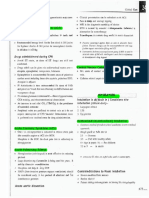0 ratings0% found this document useful (0 votes)
15 viewsCapno 1
Capno 1
Uploaded by
BiswajitCopyright:
© All Rights Reserved
Available Formats
Download as PDF or read online from Scribd
Capno 1
Capno 1
Uploaded by
Biswajit0 ratings0% found this document useful (0 votes)
15 views1 pageCopyright
© © All Rights Reserved
Available Formats
PDF or read online from Scribd
Share this document
Did you find this document useful?
Is this content inappropriate?
Copyright:
© All Rights Reserved
Available Formats
Download as PDF or read online from Scribd
Download as pdf
0 ratings0% found this document useful (0 votes)
15 views1 pageCapno 1
Capno 1
Uploaded by
BiswajitCopyright:
© All Rights Reserved
Available Formats
Download as PDF or read online from Scribd
Download as pdf
You are on page 1of 1
[4 End Tidal Capnographs. (EtCO2)
Definition: Capnography is the measurement of
CO? in respiratory gases.Itis the graphic display
of instantaneous CO2 concentration verses time
‘(ame capnogram) o- expred volume (volume
‘apnogram) during respiratory cycle.
Importance of Capnography:
+ Position of the endotracheal tube.
+ Provides information about Co2 production
+ Pulmonary pertusion|
+ Alveolar ventilation
+ Respiratory pattern
+ Elimination of the Co2 from anesthesia circuit
& ventilator.
Physics:
+ Infrares spectrography
+ Raman spsctrography
+ Mass spectrography
+ photo zeoustic spectrography
+ Chemical calorimetric spectroaraphy.
‘The infrared method 's most commonly & widely
used.
Principle
+ Princiole gas absorb infra-red radiations
producing bands in the IR electromagnetic
‘spectrum.
+ CO2 shows strong absorption at 4.3 mill
micton 16 IR. (IR rays also absorb by other
polyatomic gases such as N20 & water
vapour)
+ Itis expressed as partial pressure in mm of
Hs,
Dra:
im’s Notes in Anesthesiology 2013
[End Tidal Capnograph. (E%C02) Continuation:
Ccinical Application:
[Elovated Base Li
3 _
Tome ‘
Seen in:
+ Rebreathing
+ Incomplete expiratory valve
+ Eynausted absoroant
+ Insufficient fresh gas flow.
+ Deliberate addition of FGF,
35 oR tO
Duck
ae YY
ha
feat:
+ Too low rates of sampling witha side stream.
Dr Acam's Notes in Anesthesiology 2013
‘ontinuations
XL, Cardiogenic Oscillations:
ling
Cave
pulley thy
‘apyte
Dr Azam’s Notes in Anesthesiology 2013
‘Types of capnographs:
+ Main stream capnographs
+ Side stream capnographs
[Main stream capnographs:
+ Acuvette containing the CO2 sensor inserted between the breathing circuit & ET=
tubo, the IR rays traverse an IR detector with inthe cuvette obtaining the need for
‘gas sampling and scavenging.
+ CO? analysis performed with in the airway.
‘Side stream capnographs:
+ CO2 sensor located inthe main unit (away from the aiiway) and a tny pump
aspirates gas samples from the patients arway through a 6 foot long capillary
{ube into the main uni.
+ The sampling tube is connected to a T-Piece inserted at the endotracheal tube or
‘anesthetic mask.
+ The flow rate is 60-200 mimi.
Capnogram:
[reportance/Applications: Continued
} Malpositon of the ET-Tube
| Ventilatory failure
} Circulatory faire
| Detective anesthetic circuit
Dr Azam’s Notes in Anesthesiology 2013
I, Absence of Platea
”
‘Seen in
« Contamination of te expleed sample gas by FGF by placing the
sampling unit near the frash gas inet.
+ Too high rate of sampling
Seen
+ Onsiruction to the ET-tube
+ Away obstruction = E.g. COPD, bronchospasm
+ Acute Asthma
Dr Azam’s Notes in Anesthesiology 2013
Release ot Toumiaued
— |Unclamping of a mejor
wscle.
[Exponential decrease in
[EtCO2: Sudden hypotension
[Creuletory arest & PE
“Wit. =
— > = Fratarentons,
You might also like
- The Subtle Art of Not Giving a F*ck: A Counterintuitive Approach to Living a Good LifeFrom EverandThe Subtle Art of Not Giving a F*ck: A Counterintuitive Approach to Living a Good LifeRating: 4 out of 5 stars4/5 (6024)
- The Gifts of Imperfection: Let Go of Who You Think You're Supposed to Be and Embrace Who You AreFrom EverandThe Gifts of Imperfection: Let Go of Who You Think You're Supposed to Be and Embrace Who You AreRating: 4 out of 5 stars4/5 (1133)
- Never Split the Difference: Negotiating As If Your Life Depended On ItFrom EverandNever Split the Difference: Negotiating As If Your Life Depended On ItRating: 4.5 out of 5 stars4.5/5 (911)
- Grit: The Power of Passion and PerseveranceFrom EverandGrit: The Power of Passion and PerseveranceRating: 4 out of 5 stars4/5 (628)
- Hidden Figures: The American Dream and the Untold Story of the Black Women Mathematicians Who Helped Win the Space RaceFrom EverandHidden Figures: The American Dream and the Untold Story of the Black Women Mathematicians Who Helped Win the Space RaceRating: 4 out of 5 stars4/5 (937)
- Shoe Dog: A Memoir by the Creator of NikeFrom EverandShoe Dog: A Memoir by the Creator of NikeRating: 4.5 out of 5 stars4.5/5 (548)
- The Hard Thing About Hard Things: Building a Business When There Are No Easy AnswersFrom EverandThe Hard Thing About Hard Things: Building a Business When There Are No Easy AnswersRating: 4.5 out of 5 stars4.5/5 (359)
- Her Body and Other Parties: StoriesFrom EverandHer Body and Other Parties: StoriesRating: 4 out of 5 stars4/5 (831)
- Elon Musk: Tesla, SpaceX, and the Quest for a Fantastic FutureFrom EverandElon Musk: Tesla, SpaceX, and the Quest for a Fantastic FutureRating: 4.5 out of 5 stars4.5/5 (481)
- The Emperor of All Maladies: A Biography of CancerFrom EverandThe Emperor of All Maladies: A Biography of CancerRating: 4.5 out of 5 stars4.5/5 (275)
- The Yellow House: A Memoir (2019 National Book Award Winner)From EverandThe Yellow House: A Memoir (2019 National Book Award Winner)Rating: 4 out of 5 stars4/5 (99)
- The Little Book of Hygge: Danish Secrets to Happy LivingFrom EverandThe Little Book of Hygge: Danish Secrets to Happy LivingRating: 3.5 out of 5 stars3.5/5 (434)
- The World Is Flat 3.0: A Brief History of the Twenty-first CenturyFrom EverandThe World Is Flat 3.0: A Brief History of the Twenty-first CenturyRating: 3.5 out of 5 stars3.5/5 (2281)
- Devil in the Grove: Thurgood Marshall, the Groveland Boys, and the Dawn of a New AmericaFrom EverandDevil in the Grove: Thurgood Marshall, the Groveland Boys, and the Dawn of a New AmericaRating: 4.5 out of 5 stars4.5/5 (273)
- The Sympathizer: A Novel (Pulitzer Prize for Fiction)From EverandThe Sympathizer: A Novel (Pulitzer Prize for Fiction)Rating: 4.5 out of 5 stars4.5/5 (125)
- A Heartbreaking Work Of Staggering Genius: A Memoir Based on a True StoryFrom EverandA Heartbreaking Work Of Staggering Genius: A Memoir Based on a True StoryRating: 3.5 out of 5 stars3.5/5 (233)
- Team of Rivals: The Political Genius of Abraham LincolnFrom EverandTeam of Rivals: The Political Genius of Abraham LincolnRating: 4.5 out of 5 stars4.5/5 (235)
- On Fire: The (Burning) Case for a Green New DealFrom EverandOn Fire: The (Burning) Case for a Green New DealRating: 4 out of 5 stars4/5 (75)
- The Unwinding: An Inner History of the New AmericaFrom EverandThe Unwinding: An Inner History of the New AmericaRating: 4 out of 5 stars4/5 (45)
- TPNDocument1 pageTPNBiswajitNo ratings yet
- OLVDocument1 pageOLVBiswajitNo ratings yet
- C SpineDocument1 pageC SpineBiswajitNo ratings yet
- Lap SXDocument1 pageLap SXBiswajitNo ratings yet
- Pulm EdemaDocument1 pagePulm EdemaBiswajitNo ratings yet
- Brain Hematoma and Massive HaemorrhageDocument1 pageBrain Hematoma and Massive HaemorrhageBiswajitNo ratings yet
- BlockDocument4 pagesBlockBiswajitNo ratings yet
- Roams Review of All Medical Subjects Pdfdrivecom PDF PDF FreeDocument31 pagesRoams Review of All Medical Subjects Pdfdrivecom PDF PDF FreeBiswajitNo ratings yet
- Capno 2Document1 pageCapno 2BiswajitNo ratings yet
- Central Line 2Document1 pageCentral Line 2BiswajitNo ratings yet
- Participant - Consent - Form - 1 - PDFDocument1 pageParticipant - Consent - Form - 1 - PDFBiswajitNo ratings yet
- Roams 2 Review of All Medical Subjects Pdfdrivecom PDF PDF FreeDocument5 pagesRoams 2 Review of All Medical Subjects Pdfdrivecom PDF PDF FreeBiswajitNo ratings yet
- Front Pages1Document4 pagesFront Pages1BiswajitNo ratings yet
- AcknowledmentDocument3 pagesAcknowledmentBiswajitNo ratings yet
- Sum Scientific Program March 3,4,5Document3 pagesSum Scientific Program March 3,4,5BiswajitNo ratings yet
- Minimally Invasive Cardiac Output Technologies In.10Document8 pagesMinimally Invasive Cardiac Output Technologies In.10BiswajitNo ratings yet
























































